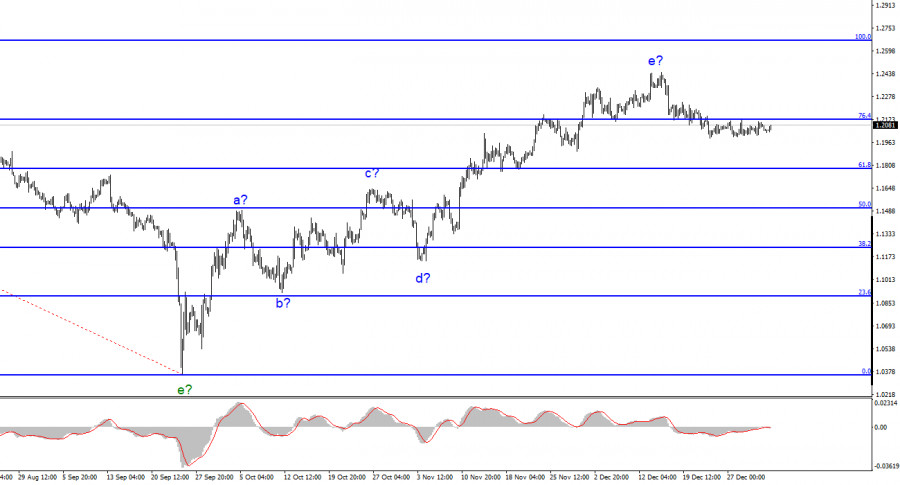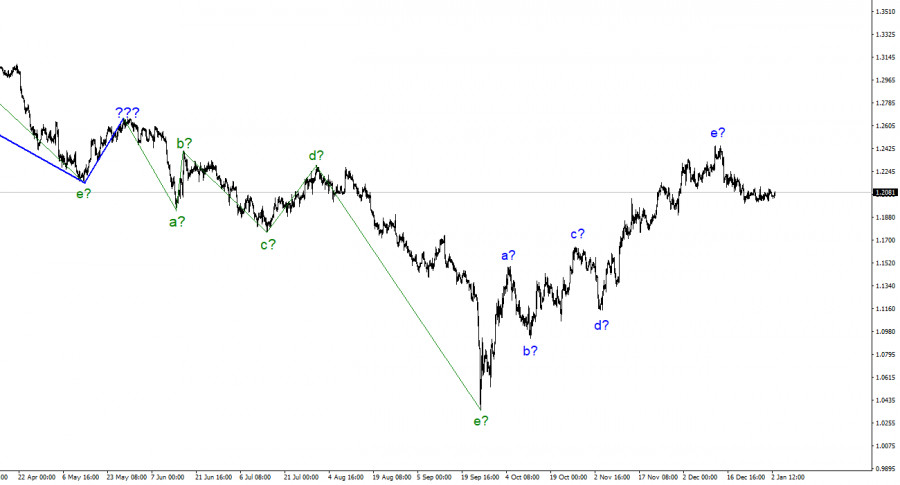
The wave marking for the pound/dollar instrument now appears very confusing, but it still does not call for any clarifications. We have a five-wave upward trend section, which has taken the form a-b-c-d-e and may already be complete. British quotes continue to actively move away from the previously set highs, increasing the likelihood of finishing the rising trend section in that market. A European, however, cannot be frozen in place indefinitely. I believe that it will eventually begin to deteriorate as well. It is challenging to sum up the recent British news background in a single word because it has been both robust and diverse. At this point, the British pound had enough reasons to rise and fall. As you can see, it primarily chose the first option, but things have since changed. The demand for the pound has peaked, and the news background (or lack thereof) already has a greater impact on this decline than anything else. Trading using this instrument is now considerably more effective because the pound's wave marking is being worked out a lot better. However, the current horizontal shift ruins the entire wave's appearance.
On Monday, the pound/dollar instrument's exchange rate fell by 50 basis points, and the amplitude is still relatively low. However, this week's news environment seems fascinating, so we can anticipate more movement. The market is currently dormant, and I'm not sure if it will awaken this week in anticipation of any significant news. The news background will progressively pick up speed. In the United States and the United Kingdom, there were no noteworthy events yesterday. Only trivial indicators of company activity in the producing sectors will be released today for December. The "minutes" of the Fed and the more significant ISM manufacturing index are both due out tomorrow.
Typically, the market is not very interested in the Fed's "minutes." I don't anticipate a significant response to this event tomorrow. This review typically doesn't include any fascinating information. Since the FOMC's members frequently remark and make announcements, the market has very few questions regarding the FOMC right now and is fully aware of the regulator's upcoming moves. It turns out that the ISM manufacturing sector index is the intriguing report below. It dropped below the crucial 50-point threshold in November, and December may see a further slide. However, given that UK economic activity is also declining across the board, I do not believe that this index will result in a decline in demand for US money. Based on everything mentioned above, it is unlikely that trading volume would increase even tomorrow. It might take until Friday before we witness any impressive maneuvers. However, Friday's numbers might also be neutral or nearly neutral. The market won't then have a reason to alter its demand for either the pound or the dollar. The entire present week could end up being joyful once more.
General conclusions
The building of a new downward trend segment is still predicted by the wave pattern of the pound/dollar instrument. I can currently recommend sales with goals around the level of 1.1508, which corresponds to a 50.0% Fibonacci ratio. The upward portion of the trend is probably over, however, it might yet take a longer form than it does right now.
The euro/dollar instrument and the picture seem extremely similar at the larger wave scale, which is fortunate because both instruments should move similarly. Currently, the upward correction portion of the trend is almost finished. If this is the case, a downward portion will likely be built for at least three waves, with the possibility of a drop in the area of the 15th figure.











